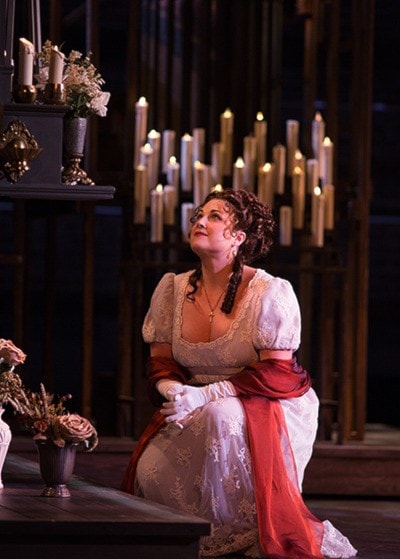Regular opera-lovers will thoroughly enjoy Pacific Opera Victoria’s production of Puccini’s Tosca. More importantly, POV provides a moving, fun and accessible production that will appeal to opera “newbies.” By curtain call, smiles and laughter flowed from stage to audience and back. Tosca serves as a wonderful ending to the 2012-2013 season, imbuing the popular melodrama with shades of wit and feeling.
In Rome, circa 1800, Floria Tosca loves the artist Mario Cavaradossi. Cavaradossi is painting a portrait of the Madonna in a church. While working, Cesare Angelotti rushes in seeking asylum (the authorities want him for resisting the party in power). The painter recognizes Angelotti, and agrees to help hide him. Tosca, visiting Cavaradossi in the church, hears other voices and suspects him of being unfaithful. Meanwhile, Baron Scarpia, the sadistic Chief of Police, tracks Angelotti to the church. Instead, he finds the artist and arrests him for harbouring a criminal. Scarpia uses this as leverage to manipulate Tosca into bedding him. She agrees to sleep with Scarpia if he releases Cavaradossi. By this time, the web of Scarpia’s deceit is so strong that four of the opera’s principle characters die by show’s end.
Joni Henson as Tosca, last seen on stage as Senta in The Flying Dutchman, thrills in the role. The character of Tosca shows her jealousy and self-regard openly, and could come across as flinty and high-maintenance in the wrong hands. Henson imbues Tosca with wit, warmth and vivacity. Her duets with Cavaradossi (“Non la suspiri...” and “Qual’occhio”) provided light comedic touches. As a result of this warmth, Tosca’s fate touches us profoundly. Cavaradossi, played by Luc Robert (everyone’s favourite “fireman-turned-opera-singer”), brings tenderness to the role. We believe his romance with Tosca.
David John Pike as Baron Scarpia paints a three-dimensional villain, which could easily have been two-dimensional. Pike’s powerful baritone voice anchors the action, like a voice from a Hellmouth. He avoids the “dastardly villain” stereotype by making Scarpia likeable and, at times, vulnerable. It is as if Sir Anthony Hopkins’s Hannibal Lecter decided to take up opera instead of kidney-chewing.
Christina Poddubiuk, the award-winning set and costume designer, has created a brilliant set. She and director Amiel Gladstone researched the Rome of 1800 and discovered that then, as today, Rome was filled with scaffolding. It is a city perpetually undergoing construction. Scaffolding, then, forms the skeleton of the set. One can glimpse the brick wall at the back of the Royal Theatre’s stage, as if the entire production emerged organically from the bricks, wood and mortar of the very theatre. The scaffolding remains in each of the three scenes as we travel from a church to Scarpia’s offices, to battlements of the Castel Sant’Angelo. Gerald King’s lighting design is exquisite, subtly shifting with the moods of each scene, ably invoking dusk or a church’s tomb-like cool or Scarpia’s luxurious office space.
Giuseppe Pietraroia conducts the Victoria Symphony brilliantly. Voices and music balanced in tone and volume, and some very difficult off-stage musical and choral cues were executed. M
Tosca runs at the Royal Theatre Fri., April 12 ay 8pm and Sun., April 14 at 2:30pm. Tickets at rmts.bc.ca or 250-386-6121.
Review by Brent Schaus
arts@mondaymag.com
